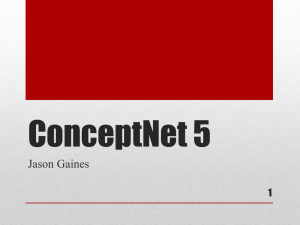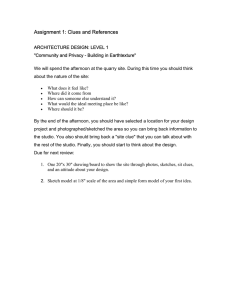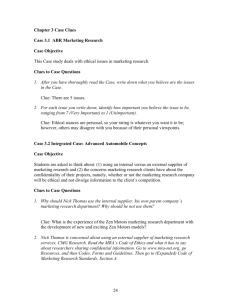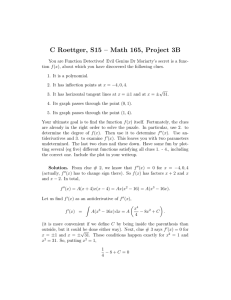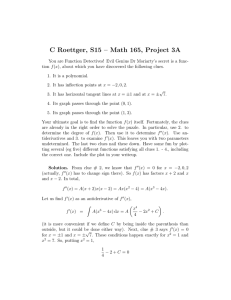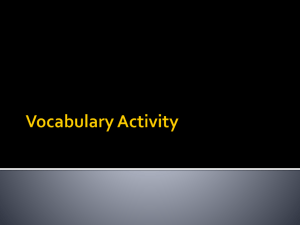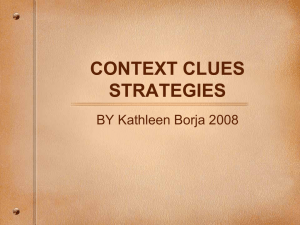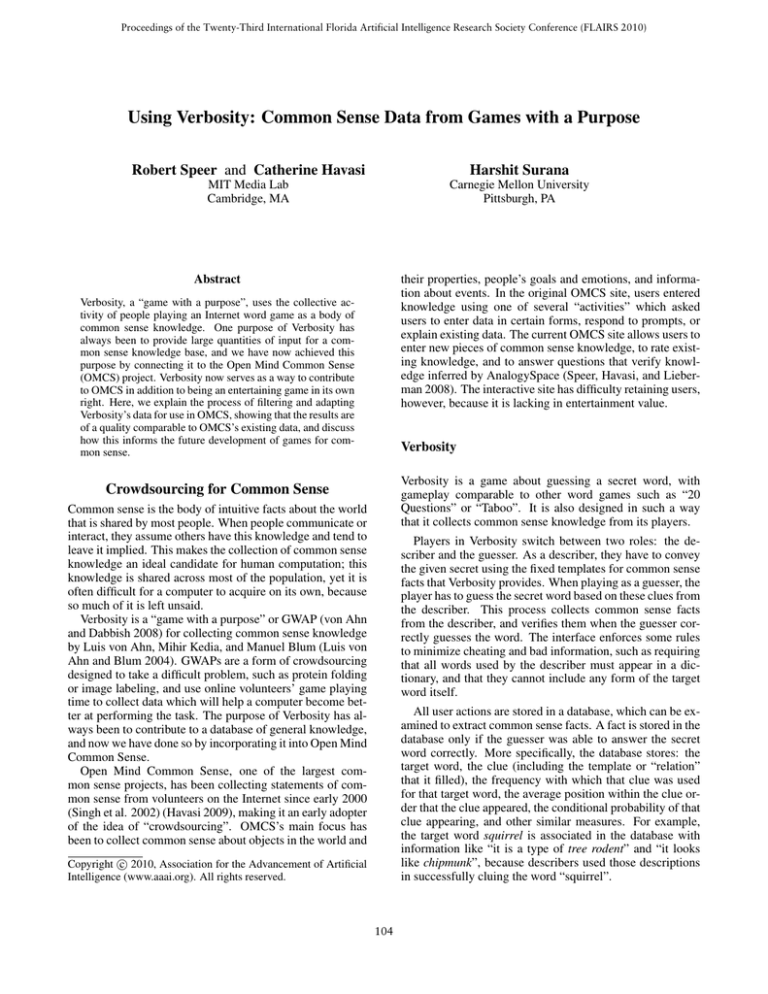
Proceedings of the Twenty-Third International Florida Artificial Intelligence Research Society Conference (FLAIRS 2010)
Using Verbosity: Common Sense Data from Games with a Purpose
Robert Speer and Catherine Havasi
Harshit Surana
MIT Media Lab
Cambridge, MA
Carnegie Mellon University
Pittsburgh, PA
their properties, people’s goals and emotions, and information about events. In the original OMCS site, users entered
knowledge using one of several “activities” which asked
users to enter data in certain forms, respond to prompts, or
explain existing data. The current OMCS site allows users to
enter new pieces of common sense knowledge, to rate existing knowledge, and to answer questions that verify knowledge inferred by AnalogySpace (Speer, Havasi, and Lieberman 2008). The interactive site has difficulty retaining users,
however, because it is lacking in entertainment value.
Abstract
Verbosity, a “game with a purpose”, uses the collective activity of people playing an Internet word game as a body of
common sense knowledge. One purpose of Verbosity has
always been to provide large quantities of input for a common sense knowledge base, and we have now achieved this
purpose by connecting it to the Open Mind Common Sense
(OMCS) project. Verbosity now serves as a way to contribute
to OMCS in addition to being an entertaining game in its own
right. Here, we explain the process of filtering and adapting
Verbosity’s data for use in OMCS, showing that the results are
of a quality comparable to OMCS’s existing data, and discuss
how this informs the future development of games for common sense.
Verbosity
Verbosity is a game about guessing a secret word, with
gameplay comparable to other word games such as “20
Questions” or “Taboo”. It is also designed in such a way
that it collects common sense knowledge from its players.
Crowdsourcing for Common Sense
Common sense is the body of intuitive facts about the world
that is shared by most people. When people communicate or
interact, they assume others have this knowledge and tend to
leave it implied. This makes the collection of common sense
knowledge an ideal candidate for human computation; this
knowledge is shared across most of the population, yet it is
often difficult for a computer to acquire on its own, because
so much of it is left unsaid.
Verbosity is a “game with a purpose” or GWAP (von Ahn
and Dabbish 2008) for collecting common sense knowledge
by Luis von Ahn, Mihir Kedia, and Manuel Blum (Luis von
Ahn and Blum 2004). GWAPs are a form of crowdsourcing
designed to take a difficult problem, such as protein folding
or image labeling, and use online volunteers’ game playing
time to collect data which will help a computer become better at performing the task. The purpose of Verbosity has always been to contribute to a database of general knowledge,
and now we have done so by incorporating it into Open Mind
Common Sense.
Open Mind Common Sense, one of the largest common sense projects, has been collecting statements of common sense from volunteers on the Internet since early 2000
(Singh et al. 2002) (Havasi 2009), making it an early adopter
of the idea of “crowdsourcing”. OMCS’s main focus has
been to collect common sense about objects in the world and
Players in Verbosity switch between two roles: the describer and the guesser. As a describer, they have to convey
the given secret using the fixed templates for common sense
facts that Verbosity provides. When playing as a guesser, the
player has to guess the secret word based on these clues from
the describer. This process collects common sense facts
from the describer, and verifies them when the guesser correctly guesses the word. The interface enforces some rules
to minimize cheating and bad information, such as requiring
that all words used by the describer must appear in a dictionary, and that they cannot include any form of the target
word itself.
All user actions are stored in a database, which can be examined to extract common sense facts. A fact is stored in the
database only if the guesser was able to answer the secret
word correctly. More specifically, the database stores: the
target word, the clue (including the template or “relation”
that it filled), the frequency with which that clue was used
for that target word, the average position within the clue order that the clue appeared, the conditional probability of that
clue appearing, and other similar measures. For example,
the target word squirrel is associated in the database with
information like “it is a type of tree rodent” and “it looks
like chipmunk”, because describers used those descriptions
in successfully cluing the word “squirrel”.
c 2010, Association for the Advancement of Artificial
Copyright Intelligence (www.aaai.org). All rights reserved.
104
collection interface was, the more they would contribute to
the project. Relatively early on, OMCS built games in an
effort to get users to work on tasks that may be perceived
otherwise as less fun or to populate data in sparse areas. The
first of these games was the Game for Interactive OpenMind
Improvement or GIOMI(Garcia, Havasi, and Todd 2002).
GIOMI was created to draw upon the OMCS community in
a new effort to rate assertions in the OpenMind database, an
unpopular activity.
The game Common Consensus (Lieberman, Smith, and
Teeters 2007) was created to quickly acquire more common
sense information on a topic or topics. Common Consensus
is based on the game Family Feud, a television game show
where contestants compete to give the most common answers in response to prompts. Ideally, Common Consensus
is played with a large group of “contestants.” Additionally,
OMCS has created its own “twenty questions” game (Speer
et al. 2009). This game’s purpose is not only to guess what
concept the user is thinking of, but also to acquire specific
pieces of knowledge which will be most useful in inferring
additional information about the concept.
Kuo et al. (Kuo et al. 2009) created two communityfocused games to collect knowledge in Chinese. These
games collected over 500,000 verified statements which
have become the OMCS Chinese database. These games,
hosted on Facebook and PTT, take advantage of the community nature of the platforms to create goal-oriented games.
Another major common sense project, Cyc, acquires common sense information from knowledge engineers (Lenat
1995). Cyc uses their game, FACTory (Cycorp 2009), to
have members of the public check facts which have been
collected from knowledge entry, machine reading, and inference.
Figure 1: Knowledge about spinach is incorporated into the
OMCS database.
Figure 2: Verbosity’s clue structure resembles OMCS’s
frame system.
ConceptNet
The statements collected by Verbosity take a form that
makes them very useful to the Open Mind Common Sense
project. In fact, they almost exactly match the data representation of ConceptNet, the semantic network representation
of OMCS.
ConceptNet (Havasi, Speer, and Alonso 2007) is largely
created from the free-text sentences that users have contributed to the OMCS database using syntactic patterns and
shallow parsing. Much of the recent information in the
OMCS database has been collected using a system of elicitation frames to ensure that their results will be easily integrated into ConceptNet (Speer 2006) without the need for
parsing.
Data entered in these frames takes the form of (concept,
relation, concept) triples. This conveniently matches Verbosity’s clue structure, as we can see in Figure 2. To make
the the Verbosity statement “It is a type of plant.” fit into the
ConceptNet framework, all one needs to do is replace the
word “it” with the target concept.
Because of this, the OMCS project has begun to integrate
knowledge from Verbosity into ConceptNet, filling a need
for more entertaining ways to add knowledge to ConceptNet. An example of how information on spinach has been
integrated can be seen in Figure 1. Using a filtering process that we will describe shortly, the OMCS project has
imported over 200,000 statements of English-language common sense from Verbosity.
Verbosity in Practice
Verbosity has been played by over thirty thousand individual
players. On an average, there are a few thousand games every day, and it remains the most popular game on gwap.com
based on gameplay statistics.
In their paper on Verbosity(Luis von Ahn and Blum
2004), von Ahn, Kedia, and Blum say they intend on “creating a system that is appealing to a large audience of people,
regardless of whether or not they are interested in contributing to Artificial Intelligence.” With so many users providing
so much knowledge, they succeeded at their goal. However,
recruiting those additional users comes with some unanticipated challenges.
Existing word games that are similar to Verbosity, like
Taboo and Charades, often encourage “outside-the-box”
ways of giving clues, such as through rhyming and word
play. Charades, in particular, comes with conventions such
as indicating the number of words and syllables, which are
not just allowed but are often expected. Tricks such as these
do not fit the purpose of Verbosity, because they tend to produce statements that are not actually true, but players may be
bringing their assumptions from other games to Verbosity.
Because the player’s primary goal in the game is to successfully communicate a word, and generating correct common
Other games for common sense
In an early questionnaire (Speer et al. 2009), top OMCS
users expressed that the more interactive a common sense
105
sense knowledge is only a vaguely related activity, many
players may not even realize this is undesirable.
Sometimes players go to even greater lengths to clue the
target word quickly, such as by spelling it out over several
clues, or by saying words that are extremely similar to the
target. This defeats the point of the game somewhat, but can
allow the player to earn points very quickly. Simply put,
people cheat at Verbosity.
In an ideal world, the clues that players entered into Verbosity would be directly usable as ConceptNet assertions. In
reality, the process of importing the Verbosity data into ConceptNet requires a considerable amount of filtering, for the
reasons we have seen above. At this point, we need to detect
the patterns that indicate cheating, frustration, or ”bending
the rules”, and remove or alter those assertions so that what
remains is reasonable common sense knowledge.
(most likely all from the same player). In all, these checks
discarded 48354 out of 448339 statements.
Look-alike and sound-alike clues
One of the relations that Verbosity prompts for is “it looks
like”. This was intended for statements about physical objects, such as “a clock looks like a circle”, but it may have
accidentally encouraged players to violate the use-mention
distinction by describing what the target word itself looks
like. This results in statements that are not true at all, but
which lead the guesser toward the correct answer anyway.
One common way that players describe what a word looks
like is to mention another word, or pair of words, that look
like the target word, such as “farmer looks like farm err”.
This would sometimes require some creativity, because Verbosity requires that all the words players use in their clues
are in its dictionary. In some cases, players would give this
kind of clue even when “it looks like” was not the relation
they were being prompted for, producing statements that
don’t even make sense as statements about words, such as
“carpet is a kind of car pet”.
Related to look-alike clues are sound-alike clues, where
players would give words that are pronounced like the target word, or – very frequently – that rhyme with the target
word. In many cases, these overlap with look-alike clues,
and players frequently (but not always) used the relation “it
looks like” for sound-alike clues as well.
Some more examples of look-alike clues and sound-alike
clues include:
Working with Verbosity data
Use and mention
Many erroneous statements in the Verbosity data come from
the fact that players often disregard the use-mention distinction. Verbosity expects players to use words to convey meaning, but in some cases, players instead mention the
words to refer to the words themselves. An example of the
use-mention distinction is illustrated by the following sentences:
• A cow has four stomachs. (Use)
• “A cow” has four letters. (Mention)
attack is a tack
belief is a kind of be leaf
chord is typically in rhymes sword
heat looks like feat meat
machine looks like mush sheen
passion looks like fashion
wander is a type of wonder
Statements that mention words as words are not particularly useful in building a common sense knowledge base.
Computers are, after all, already good at determining the
properties of strings without regard to their meaning. Because people did not actually use quotation marks to distinguish use from mention, we need to detect these “mention”
statements and discard them.
To deal with the many instances of look-alike and soundalike clues, whether they used the ”it looks like” relation or
not, we ran a script to detect them. As false negatives (letting
erroneous statements through) are worse than false positives
(keeping correct statements out of the database), this script
aggressively matched and discarded anything that could be
a look-alike or sound-alike clue.
To determine if two strings looked alike, we calculated
the average of (a) the length of their longest common prefix,
(b) the length of their longest common suffix, (c) the length
of their longest common substring, and (d) the edit distance
between the two strings, subtracted from the length of the
shorter string. The look-alike factor can then be defined as
this average divided by the length of the shorter string. By
experimenting on test data, we decided that we should reject
all statements where the look-alike factor between the target
word and the clue was over 0.35.
Some phonetic similarities, of course, are not detected by
the look-alike factor. The sound-alike factor of two strings
could be calculated by replacing all words with their first
entry in the CMU Phonetic Dictionary (cmudict.0.7a),
and calculating the look-alike factor of the result.
Flag words
When certain words appear in a clue, they are “red flags”
that the describer is mentioning the target word instead of
using it. By inspecting the database, we decided to filter out
statements that contained any of the following words or their
derived forms: letter, rhyme, blank, word, syllable, spell,
tense, prefix, suffix, start, end, plural, noun, verb, homonym,
synonym, antonym.
Other words indicate that the describer is referring to previous clues or the guesser’s previous guesses, which also
does not help in collecting common sense. For example, one
player gave the clues “it looks like accord”, “it has dance”,
and “it is add them” to clue the word ”accordance”. To deal
with these cases, we also filtered out the words guess, opposite, close, only, just, different, this, that, these, and those,
and clues that started with add, delete, or remove.
Along similar lines, we filtered out clues that ended with
a single letter word or that contained fewer than three letters
overall (because these were often involved in spelling the
target word), and we filtered out the word mince because for
some reason it was included in over 1300 nonsensical clues
106
Finally, because some players used multiple look-alike
or sound-alike words in their clue, as in the example “heat
looks like feat meat”, we also calculated the average lookalike factor and sound-alike factor between the target word
and each individual word in the clue.
So at the top level, we rejected a statement if any of these
quantities were over 0.35:
• The look-alike factor between the target and the clue
• The sound-alike factor between the target and the clue
• The average look-alike factor between the target and all
words of the clue
• The average sound-alike factor between the target and all
words of the clue
We call this maximum the text similarity factor. The distribution of text similarity factors over all statements that
passed the “flag words” step is shown in Figure 3. We discarded 47115 clues that had a text similarity factor over 0.35.
Figure 3: The distribution of text similarity factors among
statements that passed previous checks.
Filtering based on score
Another way of filtering the statements that resulted from
Verbosity is to examine the statistics that were collected for
each Verbosity statement, especially the number of times it
was asserted and where it appeared in the sequence of clues.
By experimentation, we decided on the following rules
for which statements to accept based on these statistics:
• Start with a score equal to the number of times the statement was asserted.
• If the statement always appears first in the clue order, increase its score by 1.
• If the relation is “it has” (which appeared frequently and
was frequently misused), decrease its score by 1.
• If the resulting score is 2 or more, accept the statement.
Figure 4: The overall classification of statements collected
from Verbosity. “Accepted” represents statements that
passed all the checks and were accepted into ConceptNet.
The effect of this process is to mostly accept statements
that are confirmed by more than one person entering them,
but to also accept many one-shot statements that were entered first in the clue order. (These statements were of generally higher quality than other one-shot statements, because
they reflect what comes to mind first for that concept, and
because players seem to enter less appropriate clues later in
the sequence when they are more frustrated.)
This is the final filter that determined whether a statement
would be accepted or rejected. Figure 4 shows the breakdown of statements that were filtered out for various reasons
and statements that were accepted.
While the relations associated with these negative statements were not always reliable, they shared an informative
core idea – “there is an important difference between these
two things”. We rephrased negative statements that used the
word “not” at the start of the clue or the “opposite” relation
to be in the form “x is not y”, so that they would form the
negation of an IsA statement in ConceptNet. (We simply
discarded clues that used the word “opposite” in the text, as
mentioned before, because too many of these appeared to be
referring to previous guesses.)
Similarly, although statements with the relation “’it looks
like” were not often literally true, they could usually be replaced by weaker, more correct statements with the relation
“it is related to”.
Rephrasing
In some cases, we rephrased Verbosity clues so that they
would be more useful and reliable as ConceptNet assertions.
A common type of clue was to express the target word in
terms of what it is not. Sometimes players used the relation
“it is the opposite of” for this, but sometimes they simply
expressed this using whatever relation was handy, as in “reserve looks like not active”, “inch is not foot”, and “plant is
related to not animal”.
Evaluating and Comparing Verbosity Data
To evaluate the result of our filtering process, we ran an
evaluation similar to previous evaluations that we have run
107
on ConceptNet (Speer, Havasi, and Lieberman 2008). People participating in the evaluation went to a Web page that
presented an assortment of ConceptNet-like statements, and
asked them to evaluate the quality of each statement. These
statements came from shuffling 20 statements from the filtered Verbosity data, 20 statements from ConceptNet that
did not come from Verbosity, and 20 randomized statements.
The randomized statements were created by taking real Verbosity statements and randomly swapping their keywords
or clues with each other, to produce generally nonsensical
statements that looked like they could come from Verbosity.
Our participants were 15 people who were familiar with
the Open Mind Common Sense project, who were not told
as they were taking the study what the different sources of
statements were. These participants as a whole evaluated
631 statements. Participants had seven options for how to assess each statement: “Generally true”, “Generally true (but
grammar is bad)”, “Sometimes true”, “Sometimes true (but
grammar is bad)”, “Don’t know / Opinion”, “Not true”, and
“Doesn’t make sense”.
The options containing “(but grammar is bad)” were used
to take into account that a statement, especially given the
constraints of Verbosity, could have awkward grammar and
still be valid. ConceptNet, too, contains statements with bad
grammar, often resulting from an input frame being too constraining or from answering a question that was automatically generated by the system. Out of 179 ConceptNet statements that were rated positively, 23 of them (12.8%) were
assessed as having bad grammar. Of 169 such Verbosity
statements, 49 (29.0%) were assessed as having bad grammar.
Disregarding assessments of the grammar, the breakdown
of responses is shown in Figure 5. For the purposes of comparison, the above responses were also converted to a 7-point
quality scale, using consecutive integers from -2 (“doesn’t
make sense”) to 4 (“generally true”).
Source
ConceptNet
Verbosity
Random
# samples
211
209
211
Mean score
2.787
2.378
-1.014
Breakdown of ratings in user evaluation
100
% of total
80
60
40
20
0
Random
Verbosity
ConceptNet
Nonsense
Not true
Don’t know / Opinion
Sometimes true
Generally true
Figure 5: The results of the evaluation, broken down by the
three sources of statements and the evaluations that people
gave them.
out some of the statements with a score of 1, but aside from
that, we have not taken the Verbosity score into account. Is it
possible that we could be getting more information about the
validity of statements by taking into account higher scores?
In Figure 6, we plot the Verbosity scores of the statements
used in our evaluation (on a log scale) against the score each
statement received in our evaluation. As both scores are constrained to integers, we make the points distinctly visible by
adding random “jitter” with a standard deviation of 0.1 to
the X and Y coordinates of each point.
Perhaps surprisingly, a linear regression on these results
shows no significant correlation between the Verbosity score
and the evaluation score, with a correlation coefficient of
only r = 0.056. There were a considerable number of wellrated statements that were asserted only once, for example,
as well as some poorly-rated statements with higher scores.
Std. error
0.123
0.148
0.0776
Inaccurate relations
Table 1: The scores resulting from the evaluation, on a scale
from -2.0 to 4.0.
Most of the difference in ratings between Verbosity and
ConceptNet came from the Verbosity statements rated as
“nonsense”. When we examine these statements, one common problem we see is that the describer would give a word
that had some common sense relation with the target word,
but it was not the relation being prompted for.
Some examples of statements rated “Doesn’t make sense”
were “leg has lower limb”, and “toy is a kind of little”. Statements rated “Not true” included “sail is a boat” and “servant
has paid help”, and statements rated positively but with bad
grammar included “pearl is related to shiny” and “produce
is a type of fruits vegetables”. These statements could all
have been improved by filling the same words into a different frame, such as “sail is an action you take using a boat”,
“a servant is paid help”, and “produce includes fruits, vegetables”.
We confirmed the difference in quality across the different sources, as shown in Table 1, using a one-way ANOVA.
The average score varied significantly among the three different data sources (F (2, 628) = 305.6, p < .0001). A
Tukey HSD test showed that the difference in score between
randomized statements and the two other data sources was
significant at the p < .01 level, and the difference between
Verbosity and the rest of ConceptNet was significant at the
p < .05 level.
Using Verbosity scores
Like ConceptNet, Verbosity assigns scores to its statements
according to how many people have asserted them. We have
used the Verbosity score so far as a rough filter, by throwing
108
Having gone through the process of augmenting OMCS
using a GWAP, this leaves us with many ideas and opportunities for future work. We hope that the lessons we have
learned and the processes we have developed are useful in
future endeavors.
References
Cycorp. 2009. Cyc web games. game.cyc.com.
Garcia, D.; Havasi, C.; and Todd, K. 2002. Interactively
improving the OpenMind database: A game for interactive
OpenMind inprovement (GIOMI). Media lab working paper, Massachusetts Institute of Technology.
Havasi, C.; Speer, R.; and Alonso, J. 2007. ConceptNet 3:
a flexible, multilingual semantic network for common sense
knowledge. In Recent Advances in Natural Language Processing.
Havasi, C. 2009. Discovering Semantic Relations Using Singular Value Decomposition Based Techniques. Ph.D. Dissertation, Brandeis University.
Kuo, Y.-l.; Lee, J.-C.; Chiang, K.-y.; Wang, R.; Shen, E.;
Chan, C.-w.; and Hsu, J. Y.-j. 2009. Community-based
game design: experiments on social games for commonsense data collection. In HCOMP ’09: Proceedings of the
ACM SIGKDD Workshop on Human Computation, 15–22.
New York, NY, USA: ACM.
Lenat, D. 1995. CYC: A large-scale investment in knowledge infrastructure. Communications of the ACM 11:33–38.
Lieberman, H.; Smith, D.; and Teeters, A. 2007. Common
Consensus: A web-based game for collecting commonsense
goals. Workshop on Common Sense for Intelligent Interfaces
ACM . . . .
Luis von Ahn, M. K., and Blum, M. 2004. Verbosity: A
game for collecting common-sense knowledge. In Proceedings of ACM Conference on Human Factors in Computing
Systems, CHI.
Singh, P.; Lin, T.; Mueller, E. T.; Lim, G.; Perkins, T.; and
Zhu, W. L. 2002. Open Mind Common Sense: Knowledge acquisition from the general public. In On the Move
to Meaningful Internet Systems, 1223–1237. London, UK:
Springer-Verlag.
Speer, R.; Krishnamurthy, J.; Havasi, C.; Smith, D.; Arnold,
K.; and Lieberman, H. 2009. An interface for targeted collection of common sense knowledge using a mixture model.
In Proceedings of the Intelligent User Interfaces Conference.
Speer, R.; Havasi, C.; and Lieberman, H. 2008. AnalogySpace: Reducing the dimensionality of common sense knowledge. Proceedings of AAAI 2008.
Speer, R. 2006. Learning Common Sense Knowledge from
User Interaction and Principal Component Analysis. Ph.D.
Dissertation, MIT Media Lab.
von Ahn, L., and Dabbish, L. 2008. General techniques
for designing games with a purpose. Communications of the
ACM August.
Figure 6: A comparison between the number of times each
statement was asserted in Verbosity versus the score it received in the evaluation.
Further Thoughts
The speed of knowledge acquisition using a successful
GWAP is much faster than the standard volunteer-based interface. But the data collected from GWAPs is also bound to
be somewhat noisier, as they are designed to bring in those
not sympathetic to or interested in the underlying greater
purpose of collecting data for computer science applications.
In this paper, we have identified many sources of noise and
ways to correct or disregard the erroneous data they produce.
Many of these, such as use/mention errors, would apply to
any similar system as well, so such a system could benefit
from the corrections we have described here.
Future games can be built these issues in mind, and one
way to do so is to similarly crowdsource the verification step.
This way, not only does the game collect new data, it also
weeds out data that will not be useful for the target system.
Such verification systems can be a separate game, or could
be built into the game itself, such as by allowing the guesser
to reward good clues from the describer. A built-in verification game has been used to good effect in the Chineselanguage pet game (Kuo et al. 2009).
Overly-strict constraints in a game such as Verbosity are
a common source of error, as players subvert the constraints
to get their idea across. As we have seen, because Verbosity
chooses the relations that the describer must fill in, the describer often ignores the relation and says what they mean.
One lesson we can learn is that games such as this should
remove constraints that are not important to the gameplay.
A future version of Verbosity could mitigate this problem
by allowing a choice of relations, leaving the problem of
how to fix existing data. One idea we propose is a part of the
game in which players would choose, out of two relations,
which one they thought connected the words most meaningfully (with “neither” available as an option). The players are
given the incentive of a bonus score, if both agree on the
same statement. If enough players agree against the status
quo, the existing statement could then be changed.
109


